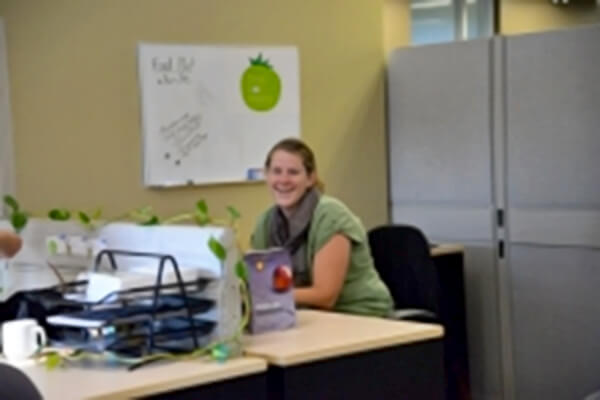Innovation is all the rage in Kitchener-Waterloo, Ont., the place I now call home.
A day does not go by without stories about another high-tech start-up in the local paper, stories that regularly achieve national prominence. It is no longer enough to describe our community as being the home to “Canada’s most innovative university” for 23 years running. Many now pride themselves on being part of an innovation hub that is the envy of much larger metropolitan centres the world over. “Silicon Valley North,” as some like to call it.
To be sure, innovation is now a preoccupation across Canada. It seems as though political, business and civic leaders everywhere are in a race to embrace change, to disrupt the economic status quo, and to create new identities for communities that can no longer count on old ways to face contemporary challenges.
This is the context that many of us are striving to be church in the midst of. Have you noticed all the hype over innovation? Does it make sense to you? Does it trouble you? How does it impact the way you think of your church?
‘Barn-raising’ innovation
While I still have some suspicions and concerns, over the past year I have come to appreciate the intentionality and effort that went into building the innovation ecosystem that is thriving in my community.
Another reason why I have become excited about building bridges with a previously unfamiliar world is that I perceived resonances with a more familiar landscape.
For example, I have met more and more people focussed on innovation not as an end in itself, but as the means to improving the human condition, or as a way to make a positive social impact. Indeed, this is another important side to our community’s innovation story that, although it is an old story, it has only recently started to get some profile. After all, long before we had BlackBerrys in our pockets, congregations and community organizations sparked creative new efforts to address poverty, crime, refugee resettlement and many other challenges.
A little over a month ago, the University of Waterloo hosted the 2015 Innovation Summit, which has become an annual gathering of global experts and leaders from the high-tech sector, universities and governments. And as I waited for the opening session to begin, I was surprised to see images of Old Order Mennonites flash across the enormous screen behind the stage.
I think it may have been David Johnston, the former University of Waterloo president and current Governor General, who first credited the “barn-raising” mentality that characterizes Kitchener-Waterloo for our successes in innovation. In any case, that image has now become a frequently used shorthand to describe the collaborative nature of our innovation ecosystem. Thus, the images of horses and buggies alongside images of impressive new buildings, 3D printers and hip looking youngsters gathered around white boards.
Although you would never know it by the way innovation leaders are idealized in the media and pop culture, the consensus of scholars is that radical innovation is always a product of collective insight and action. It isn’t a solitary pursuit.
Innovation is the result of people helping each other, and innovation ecosystems are characterized by a “pay it forward” ethos in which assistance is offered without expecting any immediate return. The unpredictability of fruitful collaboration seems to cultivate an attitude of generosity, not hubris. Trust, rather than secrecy, is the norm.
In addition to this emphasis on collaboration, another counterintuitive discovery for me was the extent to which scholars of innovation insist that our most cherished technological innovations don’t actually contain anything new. They are just new combinations of old things, or old things put to new use. Thus, the more interesting and varied the materials you have to work with, and the more you can empathize with potential users, the more creative you can be.
What this understanding of innovation looks and feels like to me is respect for the past and an appreciation for diversity, more than being enamoured with the latest and greatest. It is something akin to what Duke University theologian Gregory Jones has termed “traditioned innovation”: an approach that doesn’t force us to choose between preserving tradition and pursuing change. Indeed, Jones argues that this is what characterizes the New Testament—the calling to bear witness to the Holy Spirit, the One who is both “making all things new” and conforming us to Christ.
Innovation, ecclesial ecosystems ‘not simply in lockstep’
To be clear, the innovation and ecclesial ecosystems I find myself in are not simply in lockstep with each other. There are both rubs and gaps to be found, and by highlighting two contributions I have gleaned from my immersion experience I think can prod the church in helpful ways:
• The first is the permission, or rather the encouragement, to take risks. Now, I realize that being a faithful church is a big responsibility, but do you ever wonder if we are playing it safe? Do you ever wonder if the sophistication of our institutional existence makes it hard to break out of our boxes and follow where the Spirit may be leading us? Over the past year, I have been humbled by those who embrace slogans such as “failure is an option.” Talk about an openness to the unknown! Talk about accepting our own humanness!
Certainly we can point to our Anabaptist forebears and other persecuted ancestors to highlight a heritage of bold and courageous risk-taking; of thriving on, rather than simply surviving, upheaval and change. And certainly this heritage is alive and well in many parts of the global Mennonite communion. So perhaps this prodding from the contemporary culture of innovation could actually move us towards a posture that aligns well with our true calling.
• A second lesson is what I have come to term “the necessity of seeing it through.” In my experience, churches have lots of great ideas. Ideas that will strengthen their communities, and, more importantly, will make the world a better place. But ideas are actually the easy part. Innovation ecosystems aren’t just concerned with generating new ideas, they are actually focussed primarily on the challenge of putting wheels to new ideas—on the hard work of figuring out how to sustainably implement, test and scale up an idea.
For all the collaborative spirit and creative energy that churches exhibit in coming up with innovative new ministries, it seems to me that the “how” questions are often an afterthought to us. How can we make it happen? How will we know if we are on the right track? How will we fund it?
A new definition of ‘incubator’
I think we Mennonites can learn something from the practice of incubation.
Incubators have long been common fixtures in the neonatal intensive care units of hospitals and on chicken farms. Warm, safe places where new life is nurtured. But if you look in the Oxford English Dictionary, you will find a new definition: in North America, an incubator can also mean “a place, especially with support staff and equipment, made available at low rent to new small businesses.”
There are now upwards of 140 business incubators across Canada, and so perhaps it isn’t surprising that the visionaries behind the Mennonite Savings and Credit Union Centre for Peace Advancement chose to include the Frank and Helen Epp Peace Incubator in the design of our new space on the Conrad Grebel University College campus in Waterloo. And like all incubators, ours is more than a space. In addition to making available the use of six “hot desks” (an office organization system that involves multiple workers using a single physical work station or surface during different time periods) and promising proximity to other new peacebuilding projects, initiatives and organizations, this fall the Peace Incubator announced a program that includes access to mentors, training workshops and seed funding.
We have developed this program because we are convinced that new approaches to advancing peace in our world need to be nurtured with intentionality and effort. In addition to paying attention to peace as a conviction or ideal, and in addition to pursuing new theories and skills of peacebuilding as a field of study or practice, we need to give due attention to the vehicles through which we can apply our values and knowledge to particular challenges and contexts. Incubation mashes together theory and practice in an entrepreneurial community of peers whose measure of success is learning and impact.
Ironically, I don’t think this attention to incubating peace is something that finds resonance in the Mennonite tradition. Indeed, I don’t think we are predisposed to put our best energy into the “how” questions, preferring instead to dwell on “why?” and “what”?
I would argue that this pattern has theological roots, going back to the anti-sacramental bent of early Anabaptists and their concern to stress that salvation depends on God’s action, not our own. I think it is also evident in our understandings of conversion and regeneration—the idea that our personal commitment to, and lived expression of, faith is a natural response to the outpouring of the Holy Spirit.
In any case, the recent embrace of the language of Christian formation in our Gather ‘Round and Shine Sunday school curricula is evidence that things may be changing, and there is now openness to enriching the traditional Mennonite emphasis on discipleship by talking more about the process of becoming a disciple of Jesus. In addition to things such as Bible study and church discipline, we now are interested in the formative nature of worship, spiritual disciplines, service, stewardship and education.
I agree that we need to be careful when talking about the formative nature of church practices. They are not simply instruments, tools or techniques. I agree with those who stress that Christian practices do not assume their formative power in a straightforward cause-and-effect fashion, but precisely because it is the Spirit who is working through them. However, insisting that making new Christian disciples is the job of the Holy Spirit should not mean that we can’t say anything about the process through which this happens.
Likewise, insisting that the development of impactful new peacebuilding initiatives depends on the power of the Holy Spirit should not mean that we can’t say anything about the process through which this happens. I wouldn’t go so far as those who suggest that incubation is a way to “engineer serendipity,” but it can create the conditions for good things to emerge that we never would have anticipated.
Just as Mennonite understandings of Christian formation have benefitted from ecumenical engagement, I am convinced that Mennonite approaches to peacebuilding can benefit from engaging the tools and resources of innovation ecosystems. Perhaps the same is true for Mennonite congregations.
Paul Heidebrecht is the director of the Mennonite Savings and Credit Union Centre for Peace Advancement. This feature is based on his presentation to the Mennonite Church Eastern Canada Pastors Breakfast on Oct. 27, 2015, at Conrad Grebel University College.
For discussion
1. What new ideas has your congregation implemented recently? Where did the ideas originate? Was the implementation a collaborative effort? How much does the fear of failure keep us from trying new ideas? Would the Mennonite church benefit from more innovation?
2. Paul Heidebrecht says that innovation is often used to preserve tradition, in that we find new ways of accomplishing something that has been around for a long time. Can you think of examples in your church or community? Does your church tend to fear or welcome new ways of doing things?
3. Heidebrecht says that “new ideas are the easy part” and the real challenge is “putting wheels to new ideas.” Do you agree? He also suggests that Mennonites tend to dwell on “why” and “what,” rather than on “how.” Do you agree? Should we be encouraging the church to take more risks?
4. In what ways was Jesus an innovator? If you were participating in a peace incubator, what ideas would you contribute? What are the challenges to implementing these ideas?
—By Barb Draper









Leave a Reply
You must be logged in to post a comment.